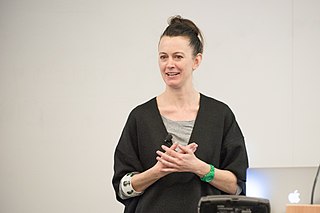
Leather is a strong, flexible and durable material obtained from the tanning, or chemical treatment, of animal skins and hides to prevent decay. The most common leathers come from cattle, sheep, goats, equine animals, buffalo, pigs and hogs, and aquatic animals such as seals and alligators.

Cultured meat, also known as cultivated meat among other names, is a form of cellular agriculture where meat is produced by culturing animal cells in vitro. Cultured meat is produced using tissue engineering techniques pioneered in regenerative medicine. Jason Matheny popularized the concept in the early 2000s after he co-authored a paper on cultured meat production and created New Harvest, the world's first non-profit organization dedicated to in-vitro meat research. Cultured meat has the potential to address the environmental impact of meat production, animal welfare, food security and human health, in addition to its potential mitigation of climate change.

Tibor Szemző is a Hungarian composer, performer, media artist. His pieces often include spoken texts, film and other media. He creates installations and composes music for his own and others’ films. Ever since the beginning of his career, he has been performing actively and widely in Hungary and abroad as well.

Paul Shapiro is an American animal welfare writer who authored the 2018 book Clean Meat: How Growing Meat Without Animals Will Revolutionize Dinner and the World. He's also the CEO and cofounder of The Better Meat Co. and the host of the Business for Good Podcast. He has delivered five TEDx talks relating to sustainable food and animal welfare. Prior to publishing Clean Meat, he was known for being an animal protection advocate, both as the founder of Animal Outlook and a Vice President at the Humane Society of the United States (HSUS).

Biobased economy, bioeconomy or biotechonomy is economic activity involving the use of biotechnology and biomass in the production of goods, services, or energy. The terms are widely used by regional development agencies, national and international organizations, and biotechnology companies. They are closely linked to the evolution of the biotechnology industry and the capacity to study, understand, and manipulate genetic material that has been possible due to scientific research and technological development. This includes the application of scientific and technological developments to agriculture, health, chemical, and energy industries.

Sustainable fashion is a term describing efforts within the fashion industry to reduce its environmental impacts, protect workers producing garments, and uphold animal welfare. Sustainability in fashion encompasses a wide range of factors, including "cutting CO2 emissions, addressing overproduction, reducing pollution and waste, supporting biodiversity, and ensuring that garment workers are paid a fair wage and have safe working conditions".
New Harvest is a donor-funded research institute dedicated to the field of cellular agriculture, focusing on advances in scientific research efforts surrounding cultured animal products. Its research aims to resolve growing environmental and ethical concerns associated with industrial livestock production.

Suzanne Lee is a Brooklyn, New York based fashion designer working on fashion and future technologies.
Eat Just, Inc. is a private company headquartered in San Francisco, California, US. It develops and markets plant-based alternatives to conventionally produced egg products, as well as cultivated meat products. Eat Just was founded in 2011 by Josh Tetrick and Josh Balk. It raised about $120 million in early venture capital and became a unicorn in 2016 by surpassing a $1 billion valuation. It has been involved in several highly publicized disputes with traditional egg industry interests. In December 2020, its cultivated chicken meat became the first cultured meat to receive regulatory approval in Singapore. Shortly thereafter, Eat Just's cultured meat was sold to diners at the Singapore restaurant 1880, making it the "world's first commercial sale of cell-cultured meat".

Beyond Meat, Inc. is a Los Angeles–based producer of plant-based meat substitutes founded in 2009 by Ethan Brown. The company's initial products were launched in the United States in 2012. The company went public in 2019, becoming the first plant-based meat analogue company to go public.

Upside Foods is a food technology company headquartered in Berkeley, California, aiming to grow sustainable cultured meat. The company was founded in 2015 by Uma Valeti (CEO), Nicholas Genovese (CSO), and Will Clem. Valeti was a cardiologist and a professor at the University of Minnesota.

The Good Food Institute (GFI) is a 501(c)(3) nonprofit organization that promotes plant- and cell-based alternatives to animal products, particularly meat, dairy, and eggs. It was created in 2016 by the nonprofit organization Mercy For Animals with Bruce Friedrich as the chief executive officer. GFI has more than 150 staff across six affiliates in the United States, India, Israel, Brazil, Asia Pacific, and Europe. GFI was one of Animal Charity Evaluators' four "top charities" of 2022.

Cellular agriculture focuses on the production of agricultural products from cell cultures using a combination of biotechnology, tissue engineering, molecular biology, and synthetic biology to create and design new methods of producing proteins, fats, and tissues that would otherwise come from traditional agriculture. Most of the industry is focused on animal products such as meat, milk, and eggs, produced in cell culture rather than raising and slaughtering farmed livestock which is associated with substantial global problems of detrimental environmental impacts, animal welfare, food security and human health. Cellular agriculture is a field of the biobased economy. The most well known cellular agriculture concept is cultured meat.
Gabor Forgacs is a Hungarian theoretical physicist turned bioengineer turned innovator and entrepreneur. He was educated in Hungary, where he earned a MS and a PhD in theoretical physics at the Lorand Eotvos University in Budapest, respectively, in 1972 and in 1976. He started his scientific career at the Central Research Institute for Physics in Budapest in condensed matter physics under the supervision of Alfred Zawadowsky. In 1978 he became the Candidate of Physical Sciences title awarded by the Hungarian National Academy. in 1978 he joined Dr. Harry Frisch at the State University of New York in Albany as a Postdoctoral Fellow and in 1979 moved to the University of Illinois at Urbana-Champaign as a Postdoctoral Fellow in the group of Professor Michael Wortis. In 1981 he returned to the Central Research Institute for Physics in Budapest and in 1984 became the Doctor of Physical Sciences of the Hungarian Academy of Sciences. In 1984-1986 he worked in the Theoretical Physics Laboratory at the Commissariat d'Energie Atomique (CEA) Saclay France. In 1988 he returned to the USA as Professor of Physics at Clarkson University, Potsdam NY. By 1992 he completed his studies in Biology, in particular the Embryology course at the Marine Biology Lab in Woods Hole and started contributing to the establishment of the new discipline of Biological Physics. In 1999 he was named the George H. Vineyard Chair Professor of Biological Physics at the University of Missouri, Columbia (UMC), where he established a Biological Physics Group at the Department of Physics and Astronomy. It is during his years at UMC that he started his entrepreneurial activity, when he started Organovo in 2007, the first company in the space of bioprinting. In 2010 he returned to Clarkson University as the Czanderna-Storky Chair Professor of Physics and the Executive Director of the Shipley Center for Innovation. In 2011 he co-founded the company Modern Meadow that focuses on biofabricated biomaterials and served as its Chief Scientific Director until 2016. In 2018 he co-founded the company Fork & Goode to produce cell-based meat and at present serves as its Chief Scientific Director.

Mosa Meat is a Dutch food technology company, headquartered in Maastricht, Netherlands, creating production methods for cultured meat. It was founded in May 2016.

Cellular Agriculture Society is a lobby organization. It is an international 501(c)(3) organization based in Miami, created in 2017 to research, fund and advance cellular agriculture.

Finless Foods, or Finless for short, is an American biotechnology company aimed at cultured fish, particularly bluefin tuna.
Aleph Farms is a cellular agriculture company active in the food technology space. It was co-founded in 2017 by the Israeli food-tech incubator "The Kitchen Hub" of Strauss Group Ltd., and Prof. Shulamit Levenberg of the Faculty of Biomedical Engineering at Technion – Israel Institute of Technology and is headquartered in Rehovot, Israel.

BioTech Foods is a Spanish biotechnology company dedicated to the development of cultured meat from the cultivation of muscle cells previously extracted from animals.

Fungi are a common theme or working material in art. They appear in many different artworks around the world, starting as early as around 8000 BCE. Fungi appear in nearly all art forms, including literature, paintings, and graphic arts; and more recently, contemporary art, music, photography, comic books, sculptures, video games, dance, cuisine, architecture, fashion, and design. There are a few exhibitions dedicated to fungi, and even an entire museum.















